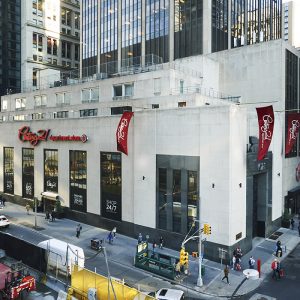We note that recent news concerning New York’s commercial real estate landscape has been rapid and stunning. Iconic businesses such as Sears, JC Penney, Modell’s and Brooks Brothers have filed for bankruptcy protection or closed retail stores, office spaces remain underutilized and the restaurant business is experiencing significant challenges. Tenants that remain are rethinking their need for expensive commercial space. Landlords are considering converting properties to new uses in order to fully lease available space. This post will examine some of the current trends in commercial leasing and provide suggestions as to how such challenges may be overcome.
Century 21, the iconic downtown Manhattan retail fixture, announced that it is closing all of its stores. As we reflect on the 9/11 terrorist attacks today, we also recall that Century 21 was committed to operating near the World Trade Center, rebuilt and reopened. Unfortunately, the effects of Coronavirus on its business could not be overcome due to the tenant’s inability to collect on its claim for business interruption insurance. Such insurance may be required by a landlord in a commercial lease. It provides that if a tenant’s business is interrupted, that lost revenues and the like will be paid and will cover the rent that the tenant could not pay due to lost revenues. Business interruption insurance covers lost revenues due to physical damage from terrorist attack or casualty, but often contains exclusions for matters such as a pandemic. Even though common sense dictates that coronavirus has interrupted business to the extent that insurers should cover the claims, many tenants have been unable to collect on such insurance and use those funds to become current on their rent obligations. Without revenues, tenants have been otherwise unable to pay their rent and have decided to vacate space.
In the office market, Covid 19 has frightened corporate leaders and employees, leading to many expecting to work from home for months to come. This is leading to high office vacancy rates and new leases (if any) for shorter terms. Subleases may become more prevalent so that tenants do not have to commit to long-term financial obligations.
Once the vacancy rate in an office building elevates or a store closes, it becomes even less attractive to visit certain locations. Nearby restaurants and stores lose business and may shutter as a result. Job loss will be a consequence. Our readers may be aware that more than 150 business leaders pleaded in writing to New York Mayor Bill de Blasio to work to restore quality of living conditions, so that they can convince their employees that New York City is a safe place to work and they will feel comfortable leaving their work from home platforms. When commercial spaces are underutilized, tax collections are reduced and municipalities have reduced revenues that support enhanced quality of life that many people seek.
Restaurants and fitness businesses have to consider a different business model. Opening rules are currently so stringent that the capacity of customers must be reduced. Further, customers may be scared to patronize these businesses, resulting in reduced revenue. The tenant may have difficulty paying the same rent as may have been calculated for more customers. The time may be ripe for a lease modification to allow for current business conditions. However, a tenant should not able to take advantage of difficult business conditions and expect that the landlord will reduce obligations for the entirety of a long-term lease. It may be prudent to reduce financial requirements in the early years of a lease and then raise them towards the end of the lease or add the forgiven amounts to the end of the lease term. This technique allows the tenant to weather the current financial storm and remain in business.
Some of these concerns are playing out differently in the suburbs. Offices away from metropolitan centers tend to be occupied to a greater extent. This may lead to even more purchasers gravitating to the suburbs for homes.
Landlords may also wish to consider conversion of their spaces to differing uses, such as retail to warehouse or retail to office. Instead of assuming that prior use will continue, being realistic is a means to allow for the property to more effectively produce income in the future. That way, landlords can collect rent rather than vacancies.
 New York Real Estate Lawyers Blog
New York Real Estate Lawyers Blog


